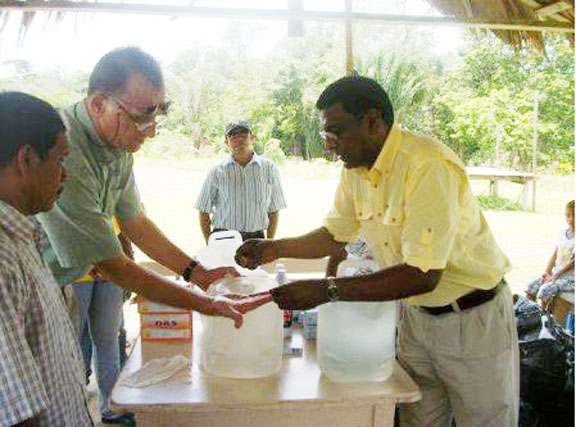A total of 529 residents from the various communities of Port Kaituma have been treated for gastroenteritis at health facilities in the area—a figure that is double the number of cases reported by the Health Ministry up to last week.
The latest figure was reported by the Government Information Agency (GINA) on Tuesday, after a recent visit by a special team that travelled to a total of eight communities, including Canal Bank, Sebai, Oronoque, Four Miles, Citrus Grove, and Mc Doom, in Region One, in response to the outbreak.
GINA noted that the Port Kaituma District Hospital saw 70% of the reported cases, while the Canal Bank Health Post saw 22% and the Sebai Health Post 8%.
It also noted that the hospital’s records indicated that three infants died as a result of the illness, and the daily average number of persons that received treatment at the various medical facilities was 25 to 30.
The increase in the number of persons complaining of gastroenteritis from the fourth week of the year within Port Kaituma has been attributed to multiple environmental health hazards, poor hygiene practices by the residents, the mining and the business community, and weather patterns.
Based on information provided by the hospital, GINA said over the eleventh week it appeared that the number of cases has been fluctuating, although the statistics show that the most affected communities are Canal Bank, Sebai, Citrus Grove, Oronoque and Central Kaituma.

Up to yesterday, Stabroek News was told that there has been a slight reduction in the number of cases seen at the hospital, while some residents remain alarmed over the situation since they still have to use the water which is said to be contaminated.
According to GINA, assessments conducted by the Ministry of Health’s government laboratory indicated that all the surface water sources tested within the targeted areas are highly contaminated. These include the water from the Port Kaituma pump station, the shallow pan at Four Miles, Sebai, and Canal Bank. The surface water sources are unfit for human consumption and personal hygiene, such as bathing, brushing of teeth, and washing of face.
Ground and rainwater sources are of much better quality, it added, but noted that the storage tanks and gutters are dirty, rendering also these unsafe for drinking and personal hygiene. “These open water sources will continue to be contaminated because of the ongoing pollution by human activities within the Port Kaituma area, the team observed,” GINA said.
Stabroek News was unable to make contact with regional officials, Minister of Health Dr. Bheri Ramsaran and Chief Medical Officer Dr. Shamdeo Persaud.
However, a health official at the hospital confirmed that there were fifteen reported cases from Port Kaituma Central, Falls Top, Fitzburg and Citrus Grove yesterday, although no one is presently hospitalised as a result of the illness.
According to the official, health teams are going house to house on a sensitisation campaign and each household is being given bleach, water treatment tablets, water bottles and Oral Rehydration Salts (ORS).
APNU MP and resident of Port Kaituma Richard Allen told Stabroek News that he remains fearful of the situation and called for everything to be done to bring it under control.
He said that from speaking to other residents, he has found that while they are using treated water, they have contracted the illness.
GINA reported that the outreach lasted for five days and was aimed at educating residents on preventative measures that could be taken to purify water to tackle gastroenteritis outbreak that hit the region about a month ago.
The special team comprised Persaud, Inter Ministerial Sector Coordina-tor for the Ministry of Health, Seewchan and representatives from the Guyana Water Inc. (GWI), Pan American Health Organisation/World Health Organisation (PAHO/WHO) and the Civil Defence Commission (CDC).
To deal with the outbreak, a District Emergency Opera-tions Centre (DEOC) was established at the Matarkai Neighbourhood Democratic Council in Port Kaituma. This centre, GINA said, seeks to provide command, control, coordination and evaluation of the response efforts within the region and it will remain active until the situation is back to normal.
A number of public education and awareness sessions were also conducted and a total of 1,000 collapsible jerry cans, 240,000 water purification tablets, 10,000 packets of ORS and bleach were distributed to residents of the affected communities.
GINA said representatives of GWI and PAHO/WHO conducted residual chlorine tests to determine the quantity of water purification tablets and bleach to be added to make the water in Port Kaituma safe for consumption. It noted that due to the high organic content of the river water, the tests indicated that 10 drops of bleach are required per gallon of river water to achieve a residual of 0.5 mg/l. This is substantially higher than the 1 – 2 drops per gallon as recommended in the public announcement.
“The water supplied by GWI in Port Kaituma is unsafe to drink and bleach should not be used to disinfect this water, due to its high organic content. Only boiling is advised to make this water safe to drink as bleach and purification tablets should only be disinfecting clear water (water without colour),” it added.




